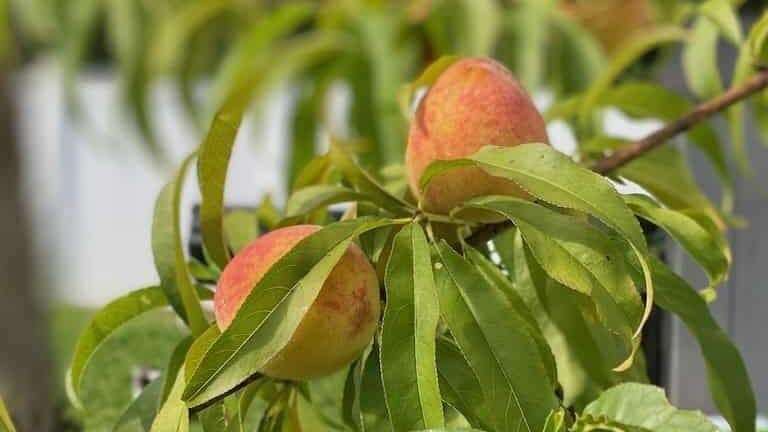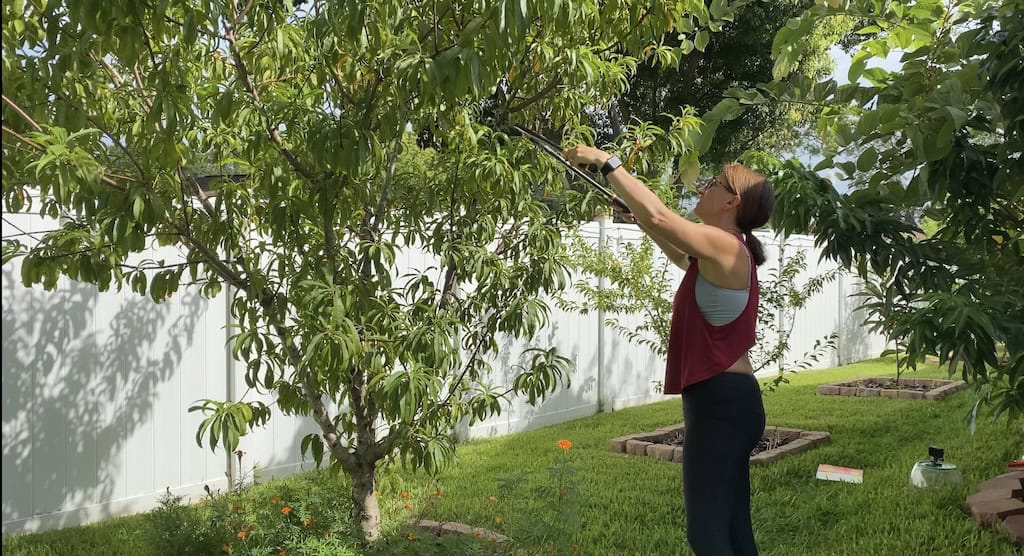Last Updated on March 26, 2025 by Homegrown Florida
Planting fruit trees in Florida is one of the best ways to create a long-term, sustainable food source right in your own backyard. But Florida’s unique climate, sandy soil, and unpredictable weather patterns mean that you need a solid plan to ensure success. The way you plant and care for your fruit trees will directly impact their growth, health, and fruit production for years to come.
Table of Contents
Choosing the Right Fruit Tree in Florida
Not all fruit trees thrive in every part of Florida. Before selecting a tree, you need to understand two key factors: chill hours and cold tolerance. Check out some of my favorite varieties.
Chill-Hour Fruits

Some fruit trees, such as peaches, plums, nectarines, apples, pears, and certain berries, require a set number of cold hours (below 45°F) to break dormancy and produce fruit. If your area doesn’t receive enough chill hours, these trees may grow but will struggle to flower and set fruit.
For example, in Central Florida, the average chill hours range from 150 to 250 per year. If you plant a peach tree that requires 500 chill hours, it won’t produce fruit reliably, if at all. When selecting a tree, choose a variety that closely matches your region’s chill hour average. If you’re in South Florida, where chill hours are minimal, you may need to skip these trees entirely or take a gamble on low-chill varieties.
Tropical and Low-Chill Fruits

If you live in a warmer area, tropical and subtropical fruits may be a better option. Trees like mangoes, avocados, papayas, bananas, pineapples, mulberries, and loquats thrive in Florida’s mild winters. However, even in Central Florida, winter cold snaps can pose a threat.
For instance, a Day avocado, which has mild cold tolerance, can handle temperatures down to about 32°F. But if a hard freeze comes through, it may suffer damage or die if left unprotected. That’s why it’s important to select varieties with some cold resistance if you live in an area that gets occasional frosts.
One of my favorite places to get fruit trees in Florida is Green Dreams. They have a great selection of trees that grow well in Florida.
Best Time Planting Fruit Trees in Florida
Timing is everything when it comes to planting fruit trees in Florida. The best time to plant in Florida is immediately after your last expected frost but before the intense summer heat kicks in.

For most of Florida, March is ideal—it gives the tree time to establish roots before the summer heat and tropical storms arrive. Waiting too long can mean planting fruit trees in Florida during the rainy season, which increases the risk of root rot, or during the scorching summer months when young trees struggle to survive.
How to Plant Fruit Trees in Florida’s Sandy Soil
Florida soil is predominantly sand, which presents both challenges and opportunities. Sand drains quickly, meaning fruit trees won’t suffer from standing water, but it also doesn’t hold nutrients well. Because of this, how you plant your tree will impact its success for years to come.

Step 1: Dig the Right-Sized Hole
Dig a hole that is twice as wide as the root ball but no deeper. The width encourages roots to spread outward, while keeping the depth shallow prevents the tree from sinking over time.
Step 2: Amend the Soil (Slightly!)
Mix in a small amount of compost with the native sand to add organic matter. However, don’t overdo it—if the surrounding soil is too rich, the tree’s roots may stay confined to the planting hole instead of spreading out to seek nutrients and water.
Step 3: Position the Tree Above Ground Level
Place the tree slightly above ground level—at least 6 inches higher than the surrounding soil. Over time, the tree will settle, and you want to ensure it remains well-drained and not sitting in a low spot where water collects.
For trees that are highly sensitive to wet feet, like avocados, consider planting on a raised mound of soil to further improve drainage.
Step 4: Water the Planting Hole Generously
Before backfilling, fill the hole with water—twice. This ensures deep moisture penetration and removes air pockets. Many people were surprised when I showed this in a video, but in Florida’s sandy soil, the water drains rapidly, and this step helps the roots get off to a strong start.
Step 5: Backfill and Mulch
Backfill the hole with the native soil and lightly tamp it down. You want to make sure that the root ball makes good contact with the soil below. Add a thick layer of mulch, such as pine bark nuggets, around the tree, leaving a few inches of space around the trunk to prevent rot.
Caring for Your Newly Planted Fruit Trees
Watering Schedule
After planting, young trees need consistent watering.
- First Week: Water every other day.
- Weeks 2–4: Water every 2–3 days.
- After the First Month: Switch to a deep soak once per week, allowing the soil to dry slightly between waterings.
This encourages roots to grow deeper, making the tree more drought-resistant in the long run.
Fertilizing
Newly planted trees don’t need much fertilizer. Over-fertilizing can cause excessive leaf growth at the expense of fruit production.
- First application: Apply a small amount of organic fruit tree fertilizer at bud break (when the tree starts forming new leaves).
- Second application: Fertilize again when the tree’s fruit is almost ready to harvest.
This method replenishes nutrients after the tree has spent energy producing fruit, ensuring strong growth for the next season. Here is my guide to everything you need to know about garden fertilizers.
Pruning and Thinning

Pruning helps shape the tree and encourages better fruit production.
- Thinning Cuts: Remove crowded branches to allow sunlight into the center of the tree.
- Height Control: Keep trees smaller for easier harvesting and maintenance.
- First-Year Fruit Thinning: Remove some of the baby fruit to prevent stress on young trees.
A heavily loaded young tree can struggle to support its fruit, leading to small, poor-quality fruit or even broken branches. By thinning fruit, you encourage larger, healthier fruit and long-term tree health.
Managing Pests and Disease
Fruit trees in Florida can attract a variety of pests, but less intervention is often better.
- Hand-Pick Pests: For minor infestations, remove insects manually instead of immediately resorting to sprays.
- Organic Sprays: If necessary, use BT (Bacillus thuringiensis) or Spinosad to target caterpillars and worms.
- Neem Oil & Insecticidal Soap: These are effective for soft-bodied pests like aphids but should be used cautiously to avoid harming beneficial insects.
For disease prevention, choosing the right variety plays a crucial role. Resistant varieties will always outperform high-maintenance ones in Florida’s humid climate.
Final Thoughts
Planting fruit trees in Florida may require some adjustments compared to other regions, but with the right variety selection, proper planting techniques, and strategic care, you’ll be rewarded with fresh, homegrown fruit for years to come.
If you’ve been thinking about planting fruit trees in Florida in your backyard, now is the perfect time to plant! Start small, pay attention to your trees’ needs, and enjoy the process. Happy gardening!


